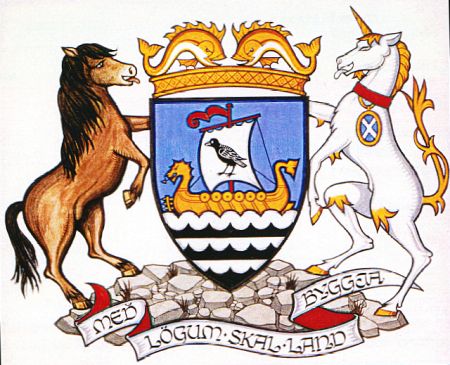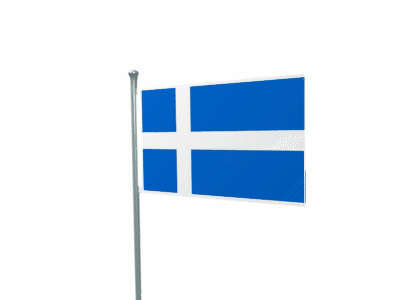Shetland and its sister archipelago of Orkney, share with Cornwall a status more akin to an assimilated territory than a straightforward county and in spite of over 500 years of Scottish and British rule, its culture remains eminently Scandinavian. This is reflected in the form of the Shetland flag, an offset cross typical of all the Scandinavian or Nordic nations,
rendered in the blue and white colours of Scotland’s Saint Andrew’s cross,
which neatly encapsulates the islands’ mingled heritage and history. Had Christian I king of Denmark and Norway paid a wedding dowry to the Scottish king in 1469, the islands would have remained outside the Scottish kingdom but they were absorbed at this time and Scottish kings fended off all attempts by the Danes to redeem them in the ensuing years. The two island chains are the last evident vestige of the once entrenched Scandinavian presence in Great Britain that began with the first Viking incursion in 793.
The flag was designed by students Roy Grønneberg and Bill Adams in 1969 to commemorate the 500th anniversary of the transfer of the islands from Norway to the Kingdom of Scotland and the 500 years before the transfer as part of Norway. A Shetland flag would symbolise the islands’ unique history. The two local authorities on the islands, Lerwick Town Council and the Zetland County Council (ZCC) were merged in 1975 into the Shetland Islands Council (SIC). The ZCC had flown its own flag ( presumably a banner of the council’s arms)

when meetings were held and following the merger of the two bodies Roy Grønneberg contacted the director of administration pointing out that the ZCC flag was no longer valid. He enclosed the design he and Bill Adams had drawn up six years earlier. The SIC then formed a flag committee of five members drawn from the public. After two meetings several designs had emerged as contenders but the matter lay unresolved for a decade.
In 1985 a representative from Shetland’s tourist office Maurice Mullay, visiting Sweden as part of a promotional campaign, was asked if Shetland had a special regional flag and recalled the Grønneberg/Adams design with its Scandinavian association, which immediately appealed to his Swedish hosts. Consequently two Swedish yachts visiting Lerwick bore the blue and white “Shetland”cross from their mast heads as a courtesy. Shetland’s participation in the 1985 Inter-island games on the Isle of Man was marked by the appearance of the flag there. Additionally the Shetland Tourist Office included the flag on its tourist literature and sold thousands of actual flags to both locals and visitors, it began to appear on boats, cars and outside hotels. Although unofficial the flag had become popular and gradually accepted as the islands’ flag.
The only serious rival to the white cross on blue was drawn up by Donnie Williamson of Lerwick, who kept the same basic form and colours but added a red square at the centre of the cross,
although no image of the flag seems available and this is a mock up based on the description. Donnie Williamson claimed that the symbolism of his flag was more complete, arguing that the red white and blue colours of his design were also those of the Union Jack and the closest neighbours, the Faroe Islands, Norway and Iceland. The Williamson flag had been seen occasionally and borne by some local vessels. Local fishermen clearly felt the need for a distinct Shetland flag, perhaps influenced by their counterparts on the mainland who had raised the Scottish Saltire on their mast-heads and painted it on their shelterdecks.
The matter was only fully resolved in 2005 when the highest heraldic authority in Scotland, the Lord Lyon made an official grant of the flag to the local council, thereby allowing the flag’s registration by the Flag Institute. Under Scottish law and unlike England or Wales, all flags must be licensed by the heraldic authority. The official recognition came in time for the 2005 Island Games and the flag was officially adopted with a description by the Shetland Islands Council (SIC) on 13 December 2006. At the same time the proportions were stated to be 3:5 with the fields by the hoist being square as in the flags of Norway, Iceland and the Faroes.
Before 2006 the flag had existed in two versions, the first had a narrow white cross and the fields at the hoist were square
the second had a wider cross and the vertical bar of the cross was nearer to the fly, thus giving the blue fields at the hoist a rectangular shape
The latter variant had appeared after about 1975.
In 2007 a Shetland Flag Day was introduced on Midsummer Day, 21 June., with the hope that the day will be used to “celebrate all things Shetland”.
Islands are by their nature separate entities and thus perhaps more naturally disposed to express themselves as something distinct and different. Coupled with a distinct, different heritage, Shetland’s self-expression in the form of a flag is not surprising. Many islanders fly their blue and white flag to express their unique character, and sense of autonomy. The flag is widely used privately by Shetlanders both on land and sea and it is now seen as a symbol of a special Shetland identity.
The flag is practically identical to the former unofficial national flag of Iceland (the Hvitblainn)
used by nationalists on the island from 1897 until 1915.
The blue used in the Shetland flag is that used in the Scottish flag, pantone 300.
The flag is regularly flown

and is much used by county sports teams.

In this county composed of islands, it is often found on vessels

and also on aircraft.

The flag has also been cleverly crafted as a necklace

and used as impressive decor here at a local restaurant.



Useful Links









